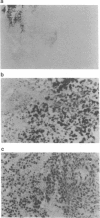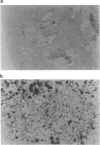Abstract
The efficacy of radioimmunotherapy of tumours with radiolabelled monoclonal antibodies (MAbs) depends on the amount of antibody taken up by the tumour and on its intratumoral distribution. In the case of MAbs directed against intracellular antigens, increasing the permeability of the cytoplasmic membrane may augment the bioavailability of the antigen for the antibody. This raises the question whether the induction of tumour necrosis by chemotherapy can enhance the tumour uptake of radiolabelled monoclonal antibodies. In this work, the effect of doxorubicin on the biodistribution of Po66, an MAb directed against an intracellular antigen, was studied in nude mice grafted with the human non-small-cell lung carcinoma cell line SK-MES-1. After injection on day 0 of 125I-labelled Po66, tumour radioactivity increased up to days 3-5, and then remained unchanged to day 14. The combined administration of 125I-labelled Po66 with 8 mg kg-1 doxorubicin, in two doses separated by 7 days, doubled the radioactivity retained by the tumour. Histological and historadiographic analysis showed, however, that the drug induced cellular damage. In the absence of doxorubicin, the accumulation of Po66 was restricted to some necrotic areas, whereas with doxorubicin the necrosis was more extensive and the antibody more evenly distributed. These results suggest that chemotherapy and immunoradiotherapy combined would enhance tumour uptake of radioisotope and promote more homogenous distribution of the radiolabelled MAb. This would promote eradication of the remaining drug-resistant cells in tumours.
Full text
PDF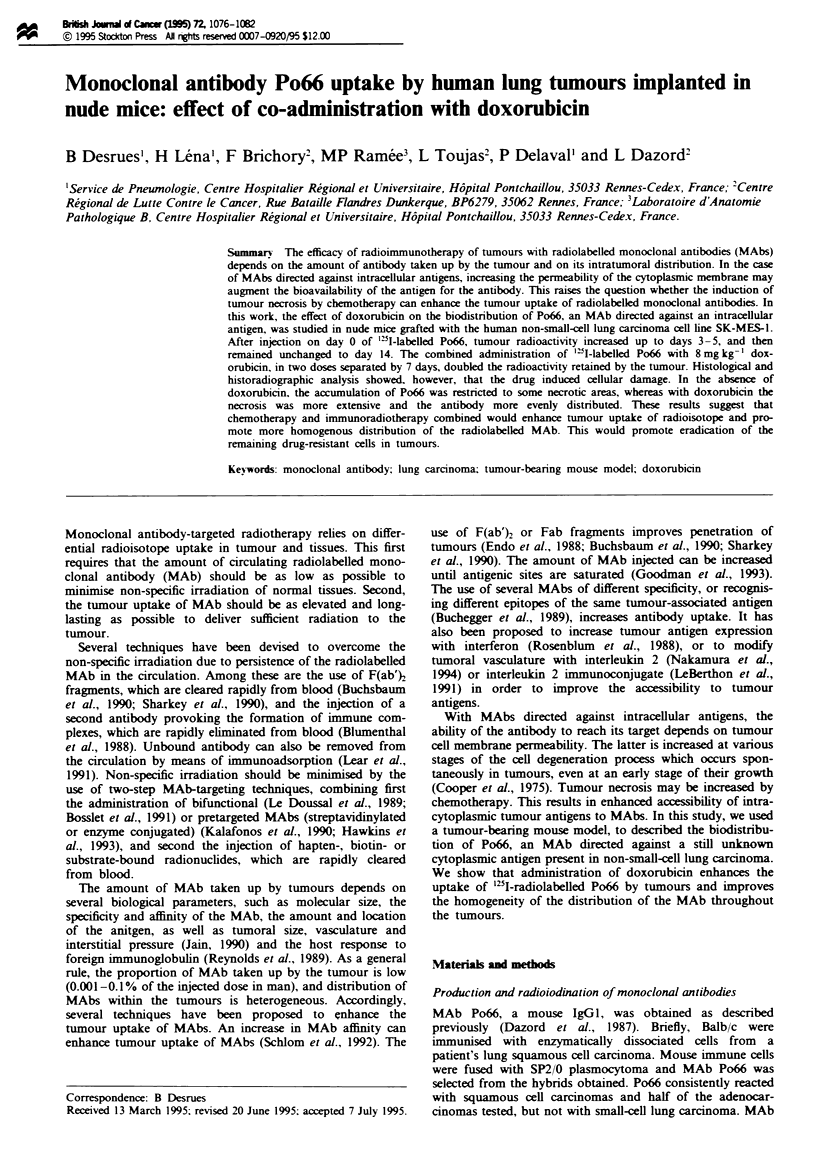
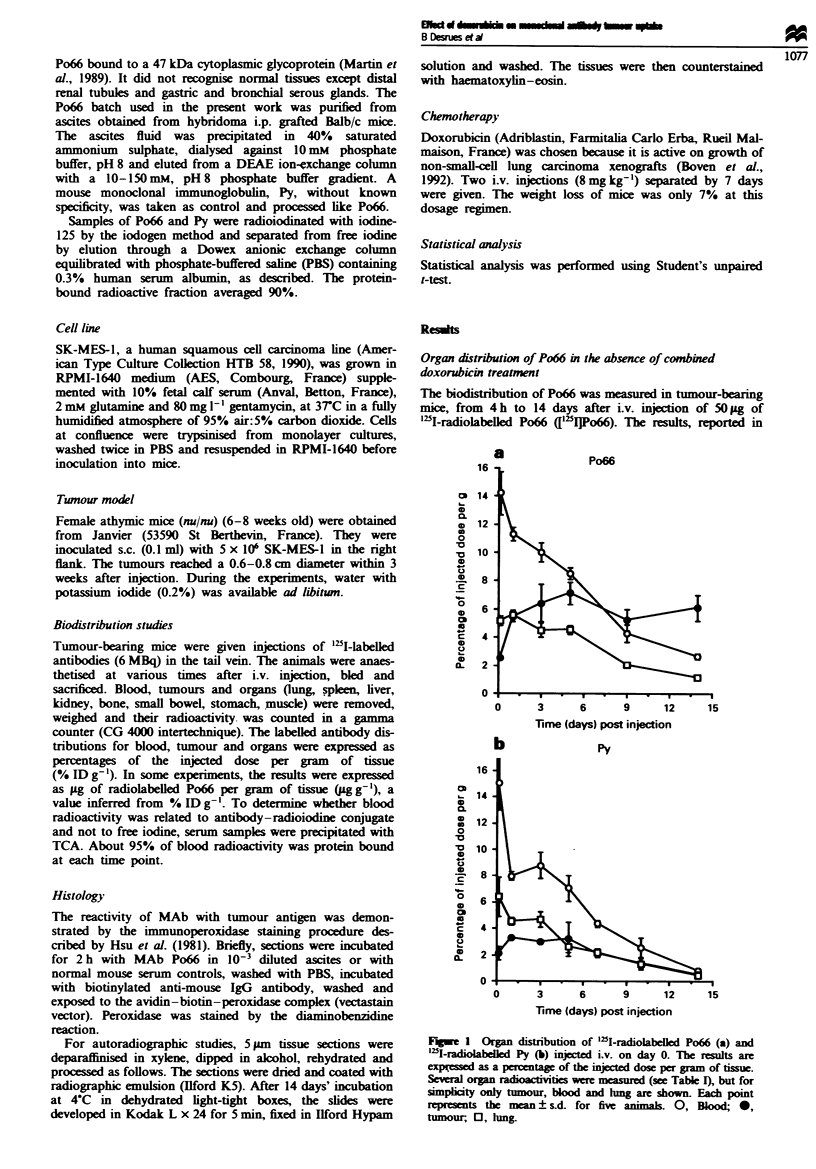
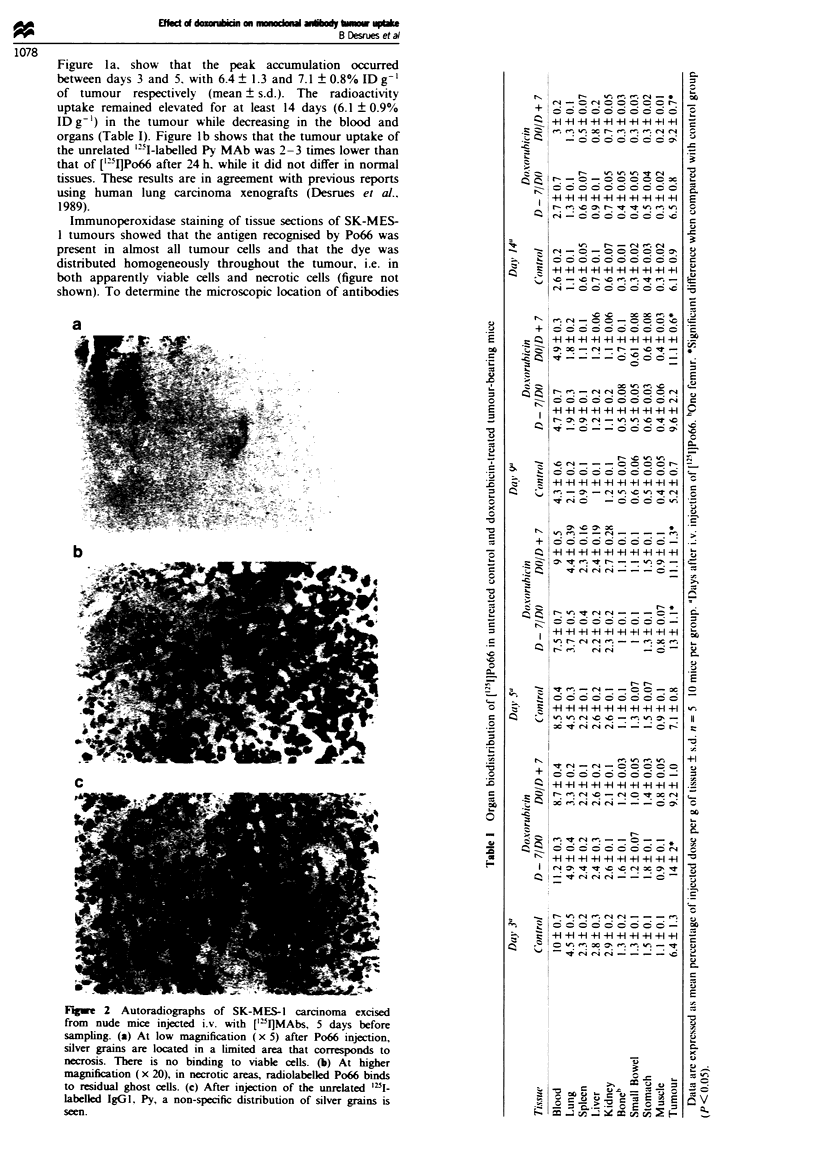
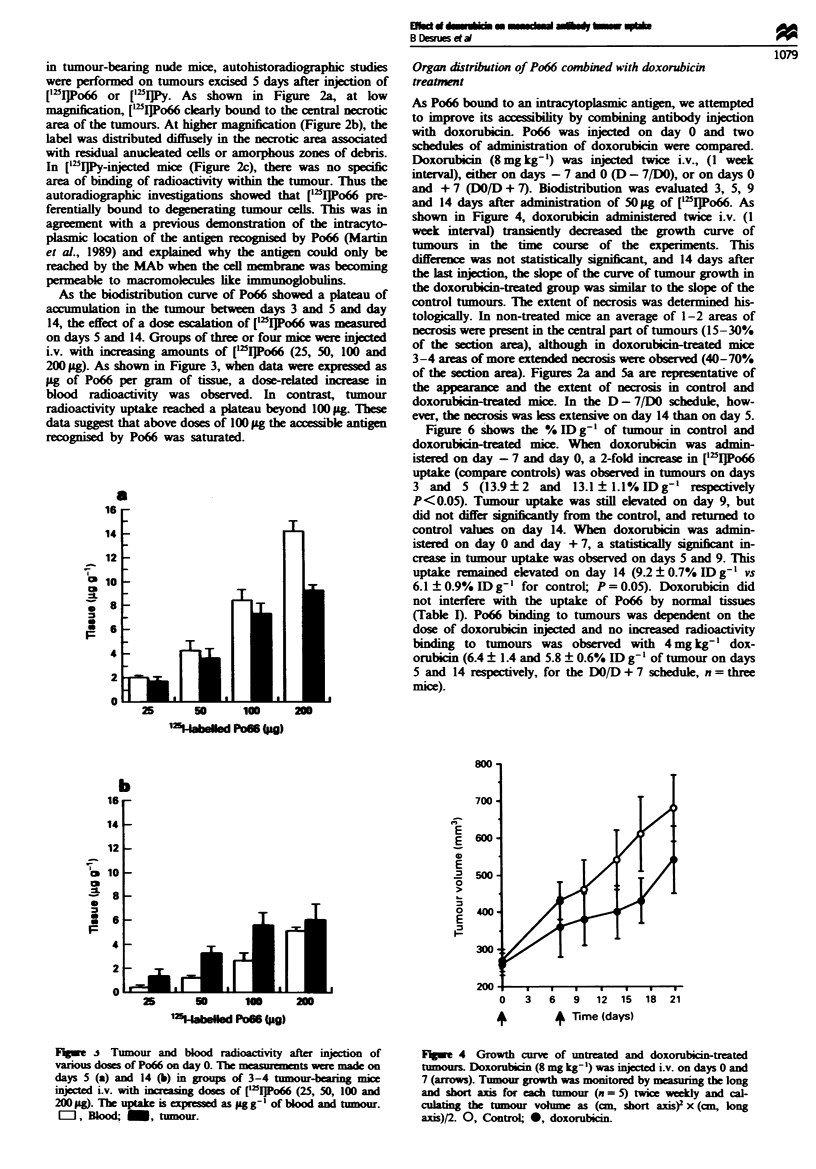
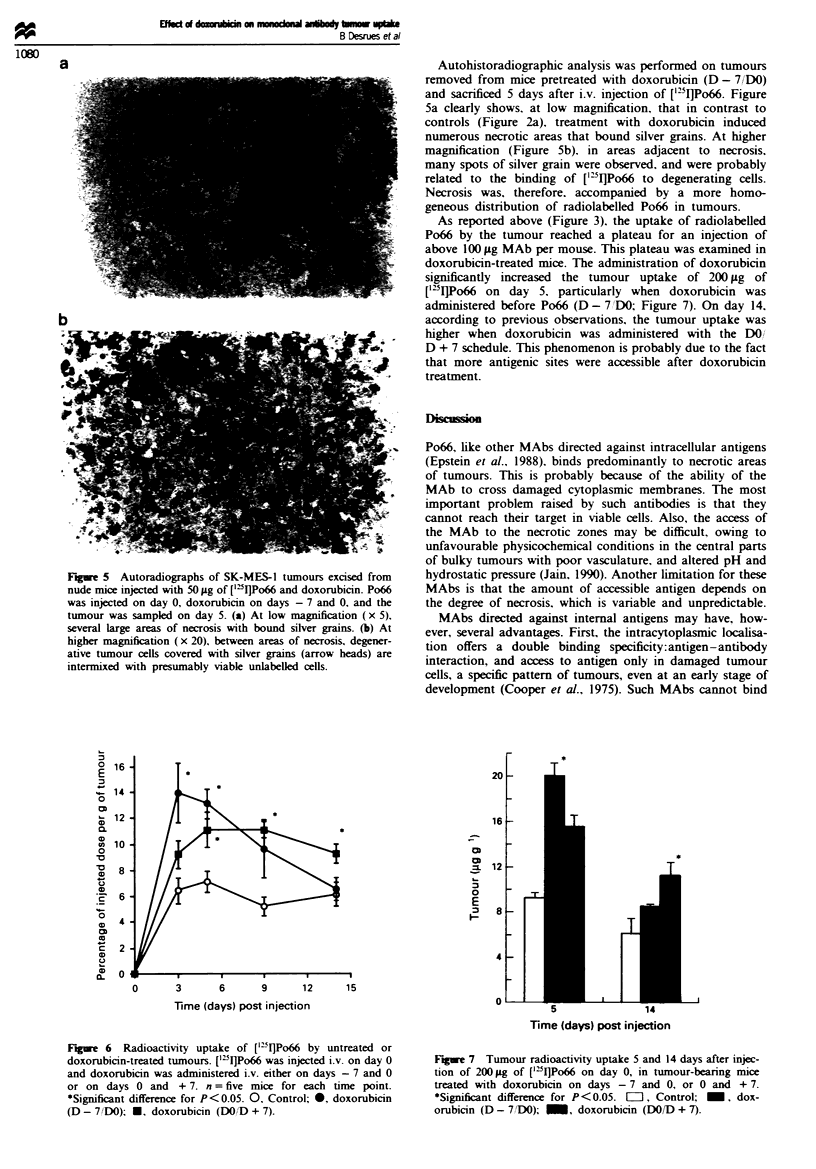

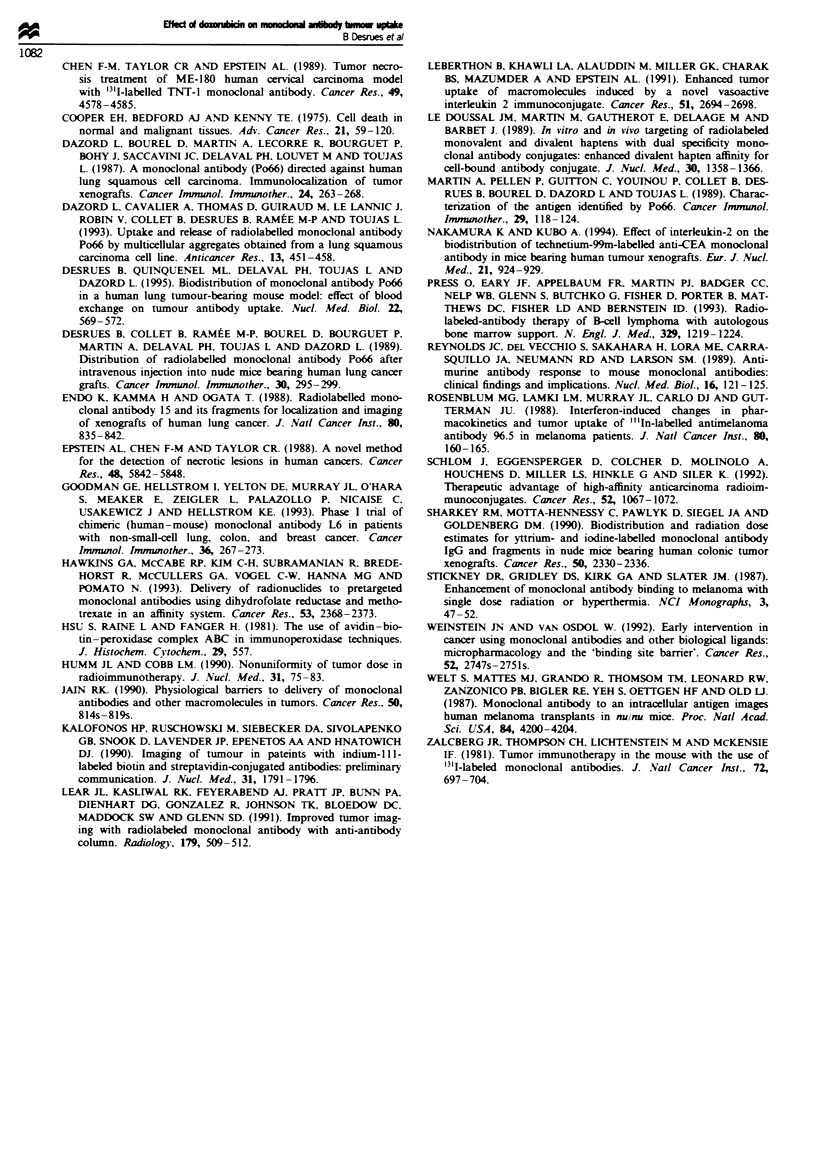
Images in this article
Selected References
These references are in PubMed. This may not be the complete list of references from this article.
- Badger C. C., Krohn K. A., Shulman H., Flournoy N., Bernstein I. D. Experimental radioimmunotherapy of murine lymphoma with 131I-labeled anti-T-cell antibodies. Cancer Res. 1986 Dec;46(12 Pt 1):6223–6228. [PubMed] [Google Scholar]
- Biol M. C., Pintori S., Mathian B., Louisot P. Dietary regulation of intestinal glycosyl-transferase activities: relation between developmental changes and weaning in rats. J Nutr. 1991 Jan;121(1):114–125. doi: 10.1093/jn/121.1.114. [DOI] [PubMed] [Google Scholar]
- Blumenthal R. D., Sharkey R. M., Snyder D., Goldenberg D. M. Reduction by anti-antibody administration of the radiotoxicity associated with 131I-labeled antibody to carcinoembryonic antigen in cancer radioimmunotherapy. J Natl Cancer Inst. 1989 Feb 1;81(3):194–199. doi: 10.1093/jnci/81.3.194. [DOI] [PubMed] [Google Scholar]
- Bosslet K., Steinstraesser A., Hermentin P., Kuhlmann L., Bruynck A., Magerstaedt M., Seemann G., Schwarz A., Sedlacek H. H. Generation of bispecific monoclonal antibodies for two phase radioimmunotherapy. Br J Cancer. 1991 May;63(5):681–686. doi: 10.1038/bjc.1991.155. [DOI] [PMC free article] [PubMed] [Google Scholar]
- Bourguet P., Dazord L., Desrues B., Collet B., Ramee M. P., Delaval P., Martin A., Logeais Y., Pelletier A., Toujas L. Immunoscintigraphy of human lung squamous cell carcinoma using an iodine-131 labelled monoclonal antibody (Po66). Br J Cancer. 1990 Feb;61(2):230–234. doi: 10.1038/bjc.1990.43. [DOI] [PMC free article] [PubMed] [Google Scholar]
- Boven E., Winograd B., Berger D. P., Dumont M. P., Braakhuis B. J., Fodstad O., Langdon S., Fiebig H. H. Phase II preclinical drug screening in human tumor xenografts: a first European multicenter collaborative study. Cancer Res. 1992 Nov 1;52(21):5940–5947. [PubMed] [Google Scholar]
- Buchegger F., Pfister C., Fournier K., Prevel F., Schreyer M., Carrel S., Mach J. P. Ablation of human colon carcinoma in nude mice by 131I-labeled monoclonal anti-carcinoembryonic antigen antibody F(ab')2 fragments. J Clin Invest. 1989 May;83(5):1449–1456. doi: 10.1172/JCI114037. [DOI] [PMC free article] [PubMed] [Google Scholar]
- Buchsbaum D. J., Brubaker P. G., Hanna D. E., Glatfelter A. A., Terry V. H., Guilbault D. M., Steplewski Z. Comparative binding and preclinical localization and therapy studies with radiolabeled human chimeric and murine 17-1A monoclonal antibodies. Cancer Res. 1990 Feb 1;50(3 Suppl):993s–999s. [PubMed] [Google Scholar]
- Carlsson J., Daniel-Szolgay E., Frykholm G., Glimelius B., Hedin A., Larsson B. Homogeneous penetration but heterogeneous binding of antibodies to carcinoembryonic antigen in human colon carcinoma HT-29 spheroids. Cancer Immunol Immunother. 1989;30(5):269–276. doi: 10.1007/BF01744893. [DOI] [PMC free article] [PubMed] [Google Scholar]
- Chen F. M., Taylor C. R., Epstein A. L. Tumor necrosis treatment of ME-180 human cervical carcinoma model with 131I-labeled TNT-1 monoclonal antibody. Cancer Res. 1989 Aug 15;49(16):4578–4585. [PubMed] [Google Scholar]
- Cooper E. H., Bedford A. J., Kenny T. E. Cell death in normal and malignant tissues. Adv Cancer Res. 1975;21:59–120. doi: 10.1016/s0065-230x(08)60971-9. [DOI] [PubMed] [Google Scholar]
- Dazord L., Bourel D., Martin A., Lecorre R., Bourguet P., Bohy J., Saccavini J. C., Delaval P., Louvet M., Toujas L. A monoclonal antibody (Po66) directed against human lung squamous cell carcinoma immunolocalization of tumour xenografts in nude mice. Cancer Immunol Immunother. 1987;24(3):263–268. doi: 10.1007/BF00205641. [DOI] [PMC free article] [PubMed] [Google Scholar]
- Dazord L., Cavallier A., Thomas D., Guiraud J. M., Le Lannic J., Robin V., Collet B., Desrues B., Ramee M. P., Toujas L. Uptake and release of radiolabelled monoclonal antibody Po66 by multicellular aggregates obtained from a lung squamous carcinoma cell line. Anticancer Res. 1993 Mar-Apr;13(2):451–457. [PubMed] [Google Scholar]
- Desrues B., Collet B., Ramé M. P., Bourel D., Bourguet P., Martin A., Delaval P., Toujas L., Dazord L. Distribution of radiolabelled monoclonal antibody Po66 after intravenous injection into nude mice bearing human lung cancer grafts. Cancer Immunol Immunother. 1989;30(5):295–299. doi: 10.1007/BF01744897. [DOI] [PMC free article] [PubMed] [Google Scholar]
- Desrues B., Quinquenel M. L., Toujas L., Delaval P., Dazord L. Biodistribution of monoclonal antibody Po66 in a human lung tumour-bearing mouse model: effect of blood exchange on tumour antibody uptake. Nucl Med Biol. 1995 Jul;22(5):569–572. doi: 10.1016/0969-8051(95)00006-j. [DOI] [PubMed] [Google Scholar]
- Endo K., Kamma H., Ogata T. Radiolabeled monoclonal antibody 15 and its fragments for localization and imaging of xenografts of human lung cancer. J Natl Cancer Inst. 1988 Aug 3;80(11):835–842. doi: 10.1093/jnci/80.11.835. [DOI] [PubMed] [Google Scholar]
- Epstein A. L., Chen F. M., Taylor C. R. A novel method for the detection of necrotic lesions in human cancers. Cancer Res. 1988 Oct 15;48(20):5842–5848. [PubMed] [Google Scholar]
- Goodman G. E., Hellstrom I., Yelton D. E., Murray J. L., O'Hara S., Meaker E., Zeigler L., Palazollo P., Nicaise C., Usakewicz J. Phase I trial of chimeric (human-mouse) monoclonal antibody L6 in patients with non-small-cell lung, colon, and breast cancer. Cancer Immunol Immunother. 1993;36(4):267–273. doi: 10.1007/BF01740909. [DOI] [PMC free article] [PubMed] [Google Scholar]
- Hawkins G. A., McCabe R. P., Kim C. H., Subramanian R., Bredehorst R., McCullers G. A., Vogel C. W., Hanna M. G., Jr, Pomato N. Delivery of radionuclides to pretargeted monoclonal antibodies using dihydrofolate reductase and methotrexate in an affinity system. Cancer Res. 1993 May 15;53(10 Suppl):2368–2373. [PubMed] [Google Scholar]
- Humm J. L., Cobb L. M. Nonuniformity of tumor dose in radioimmunotherapy. J Nucl Med. 1990 Jan;31(1):75–83. [PubMed] [Google Scholar]
- Jain R. K. Physiological barriers to delivery of monoclonal antibodies and other macromolecules in tumors. Cancer Res. 1990 Feb 1;50(3 Suppl):814s–819s. [PubMed] [Google Scholar]
- Kalofonos H. P., Rusckowski M., Siebecker D. A., Sivolapenko G. B., Snook D., Lavender J. P., Epenetos A. A., Hnatowich D. J. Imaging of tumor in patients with indium-111-labeled biotin and streptavidin-conjugated antibodies: preliminary communication. J Nucl Med. 1990 Nov;31(11):1791–1796. [PubMed] [Google Scholar]
- Le Doussal J. M., Martin M., Gautherot E., Delaage M., Barbet J. In vitro and in vivo targeting of radiolabeled monovalent and divalent haptens with dual specificity monoclonal antibody conjugates: enhanced divalent hapten affinity for cell-bound antibody conjugate. J Nucl Med. 1989 Aug;30(8):1358–1366. [PubMed] [Google Scholar]
- LeBerthon B., Khawli L. A., Alauddin M., Miller G. K., Charak B. S., Mazumder A., Epstein A. L. Enhanced tumor uptake of macromolecules induced by a novel vasoactive interleukin 2 immunoconjugate. Cancer Res. 1991 May 15;51(10):2694–2698. [PubMed] [Google Scholar]
- Lear J. L., Kasliwal R. K., Feyerabend A. J., Pratt J. P., Bunn P. A., Dienhart D. G., Gonzalez R., Johnson T. K., Bloedow D. C., Maddock S. W. Improved tumor imaging with radiolabeled monoclonal antibodies by plasma clearance of unbound antibody with anti-antibody column. Radiology. 1991 May;179(2):509–512. doi: 10.1148/radiology.179.2.1849662. [DOI] [PubMed] [Google Scholar]
- Martin A., Pellen P., Guitton C., Youinou P., Collet B., Desrues B., Bourel D., Dazord L., Toujas L. Characterization of the antigen identified by Po66. A monoclonal antibody raised against a lung squamous cell carcinoma. Cancer Immunol Immunother. 1989;29(2):118–124. doi: 10.1007/BF00199286. [DOI] [PMC free article] [PubMed] [Google Scholar]
- Nakamura K., Kubo A. Effect of interleukin-2 on the biodistribution of technetium-99m-labelled anti-CEA monoclonal antibody in mice bearing human tumour xenografts. Eur J Nucl Med. 1994 Sep;21(9):924–929. doi: 10.1007/BF00238115. [DOI] [PubMed] [Google Scholar]
- Press O. W., Eary J. F., Appelbaum F. R., Martin P. J., Badger C. C., Nelp W. B., Glenn S., Butchko G., Fisher D., Porter B. Radiolabeled-antibody therapy of B-cell lymphoma with autologous bone marrow support. N Engl J Med. 1993 Oct 21;329(17):1219–1224. doi: 10.1056/NEJM199310213291702. [DOI] [PubMed] [Google Scholar]
- Reynolds J. C., Del Vecchio S., Sakahara H., Lora M. E., Carrasquillo J. A., Neumann R. D., Larson S. M. Anti-murine antibody response to mouse monoclonal antibodies: clinical findings and implications. Int J Rad Appl Instrum B. 1989;16(2):121–125. doi: 10.1016/0883-2897(89)90182-7. [DOI] [PubMed] [Google Scholar]
- Rosenblum M. G., Lamki L. M., Murray J. L., Carlo D. J., Gutterman J. U. Interferon-induced changes in pharmacokinetics and tumor uptake of 111In-labeled antimelanoma antibody 96.5 in melanoma patients. J Natl Cancer Inst. 1988 Apr 6;80(3):160–165. doi: 10.1093/jnci/80.3.160. [DOI] [PubMed] [Google Scholar]
- Schlom J., Eggensperger D., Colcher D., Molinolo A., Houchens D., Miller L. S., Hinkle G., Siler K. Therapeutic advantage of high-affinity anticarcinoma radioimmunoconjugates. Cancer Res. 1992 Mar 1;52(5):1067–1072. [PubMed] [Google Scholar]
- Sharkey R. M., Motta-Hennessy C., Pawlyk D., Siegel J. A., Goldenberg D. M. Biodistribution and radiation dose estimates for yttrium- and iodine-labeled monoclonal antibody IgG and fragments in nude mice bearing human colonic tumor xenografts. Cancer Res. 1990 Apr 15;50(8):2330–2336. [PubMed] [Google Scholar]
- Stickney D. R., Gridley D. S., Kirk G. A., Slater J. M. Enhancement of monoclonal antibody binding to melanoma with single dose radiation or hyperthermia. NCI Monogr. 1987;(3):47–52. [PubMed] [Google Scholar]
- Weinstein J. N., van Osdol W. Early intervention in cancer using monoclonal antibodies and other biological ligands: micropharmacology and the "binding site barrier". Cancer Res. 1992 May 1;52(9 Suppl):2747s–2751s. [PubMed] [Google Scholar]
- Welt S., Mattes M. J., Grando R., Thomson T. M., Leonard R. W., Zanzonico P. B., Bigler R. E., Yeh S., Oettgen H. F., Old L. J. Monoclonal antibody to an intracellular antigen images human melanoma transplants in nu/nu mice. Proc Natl Acad Sci U S A. 1987 Jun;84(12):4200–4204. doi: 10.1073/pnas.84.12.4200. [DOI] [PMC free article] [PubMed] [Google Scholar]
- Zalcberg J. R., Thompson C. H., Lichtenstein M., McKenzie I. F. Tumor immunotherapy in the mouse with the use of 131I-labeled monoclonal antibodies. J Natl Cancer Inst. 1984 Mar;72(3):697–704. [PubMed] [Google Scholar]



